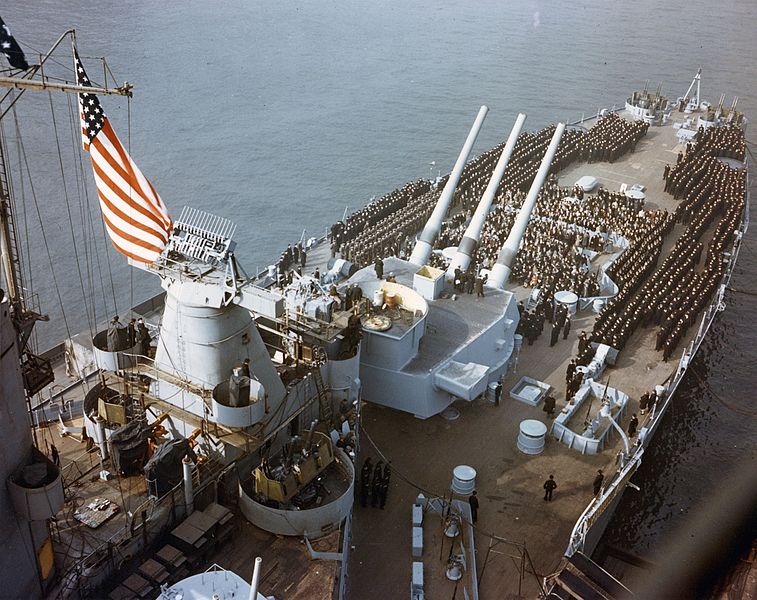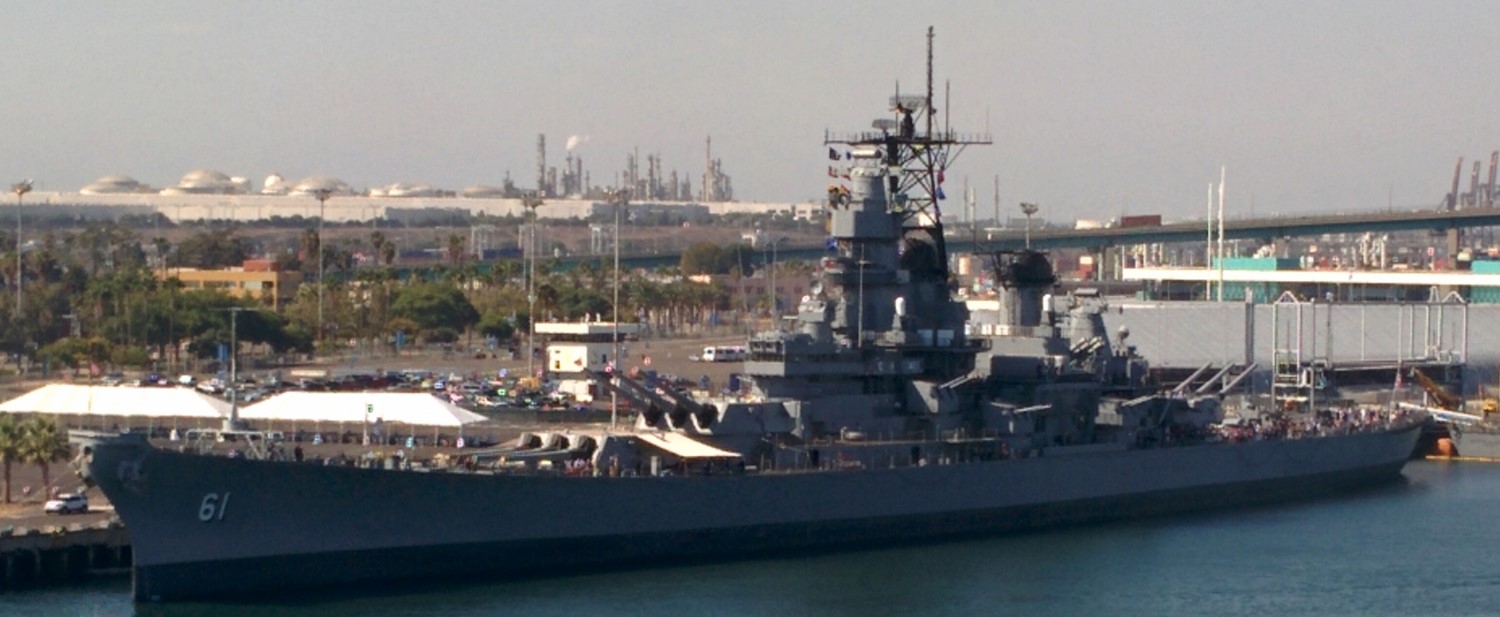I've discussed in great detail many of Iowa's systems, but never really talked too much about her history, so I thought that would make a good topic to start out with here.
USS Iowa (BB-61) was the fourth ship of the US Navy to bear the name, although only one of the previous three ships actually saw service.2

Iowa/Ammonoosuc
The first was a Civil War-era steam frigate, originally named Ammonoosuc,3 which was never commissioned after her completion in 1868 and was eventually sold for scrap in 1883.4

USS Iowa (BB-4)
The second was America’s first seagoing battleship, BB-4. She was a pre-dreadnought, laid down in 1893, and commissioned in 1897. She had higher freeboard than the proceeding Indiana class, four 12” guns, eight 8” guns, and six 4” QF guns. She made 17 knots on her trials, and displaced 11,400 tons. Iowa was the newest and most powerful battleship in the fleet during the Spanish-American war, and participated in the bombardment of San Juan, Puerto Rico, and the battle of Santiago de Cuba, the climactic battle of the war. After the war, she was rapidly rendered obsolete by the developing US fleet, and only served as a training ship during WWI, before being turned into a radio-controlled target ship. She was sunk in 1923 during exercises.

A drawing of the South Dakota-class
The third Iowa (BB-53) was a member of the South Dakota class, cancelled by the Washington Naval Treaty. She was laid down in 1920 and suspended in 1922 while 32% complete, then scrapped a year later.

USS Iowa (BB-61) during shakedown
The fourth Iowa (BB-61) was the lead ship of her class, the last class of battleships built by the US, and the best built anywhere. I’ve covered the design background of the class elsewhere, and will focus on the ship herself here.
Iowa was ordered on July 1st, 1939, under the Second Vinson Act of 1938. She was laid down at the New York Naval Shipyard in Brooklyn on June 27th, 1940, and launched on August 27th, 1942. Ships are traditionally assigned a female sponsor to launch them, Iowa’s being Ilo Wallace, wife of then-Vice President Harry Wallace.

Iowa being launched
It took another six months to finish fitting the ship out, and she commissioned under the command of Captain John McCrea on February 22nd 1943, and went to sea for a shakedown cruise two days later.
Iowa continued working up until July 16th, when she briefly ran aground while trying to enter Casco Bay, Maine, a tricky passage at the best of times. 252 ft of the ship’s bottom was damaged, in some cases to a depth of 30 in, and she was in the yard for over a month for repairs.5 Captain McCrea’s career was endangered, although he was saved by his reputation as a good shiphandler and President Roosevelt’s intervention, as he had previously been Roosevelt’s naval aide.

Iowa's commissioning
On August 27th, she was sent to Newfoundland, apparently to guard against the possibility of the German battleship Tirpitz breaking into the North Atlantic. This is rather confusing, as Iowa was on the wrong side of the Atlantic to be really effective in this role, and I suspect that she was there more for training than for actual operations.
October 25th saw Iowa in Norfolk Navy Yard in preparation for her first mission. She was assigned to take FDR across the Atlantic to the Cairo and Tehran conferences, and during the process two elevators (for FDR’s wheelchair) and a bathtub were installed on the ship. The bathtub is still there, although the elevators were removed before Iowa went to the Pacific. FDR came aboard on November 11th, and Iowa set off with her escorts.

USS William D. Porter
On the 14th, partway across the Atlantic, one of the escorting destroyers, the USS William D. Porter, was conducting a practice torpedo attack on the Iowa. The torpedo primers had been removed for safety. Well, the primers for tubes 1 and 2 were removed. The primer for tube 3 wasn’t, although they didn’t realize this until they launched a live torpedo at the battleship carrying the President.
At this point, things get unclear. The common account says that the Porter signaled via blinker twice, messing up both times, before getting on the radio to inform Iowa of the incoming torpedo. Roosevelt asked to be taken to the railing to see the torpedo, and his Secret Servicemen drew their revolvers in preparation to shoot at the torpedo.
Iowa successfully dodged the torpedo, which detonated in the ship’s wake, shaking the ship slightly. After that, they asked the Porter where the torpedo had come from, and upon receiving the answer that Porter had launched it, trained all guns on the destroyer. She was immediately ordered back to Bermuda where the entire crew was placed under arrest.
At least part of this is not true. I managed to track down copies of the war diaries of all of the ships involved, and several elements were immediately disproven. Most notably, Porter actually continued to escort Iowa until her scheduled relief,7 and there is no mention of any arrest at Bermuda. The war diaries did not mention the signal issues, although I’m not sure they would have been included. The statements on Roosevelt are unsourced, and given the amount of legend surrounding this incident, I suspect they were enhanced to make a better story.8
We do know that Chief Torpedoman Lawton Dawson, who had been responsible for removing the primer before the exercise, threw it over the side and was later sentenced to 14 years for the incident. I suspect this was for destroying the evidence, and not the incident itself, although I don’t have documents to back this up. Roosevelt pardoned him, on the grounds that it had been an accident.
There are several other incidents that are attributed to the Porter on that trip, including banging into other destroyers while leaving port, losing depth charges over the side, and nearly hitting Iowa with AA fire. None of the war diaries of the ships involved mention said incidents, and I suspect they happened to other ships and have been attributed to the Porter to make the story better.10
Porter was soon ordered to the Pacific, where she was frequently greeted with signals of “Don’t shoot, we’re Republicans”. She served in the Aleutians campaign, and then in the invasions of the Philippines and Okinawa. Off Okinawa, while serving as a fighter-direction ship, she was sunk by one of the strangest Kamikaze attacks of the war. An attacking Val dive-bomber was shot down ahead of the destroyer, and sank, then floated up underneath the ship. The Val’s bomb detonated, breaking Porter’s back. She sunk three hours later, but all of her crew got off.

Porter sinking off Okinawa
Iowa dropped Roosevelt off in Algeria, and was promptly ordered out of the Mediterranean due to the threat of German guided bomb attacks. She headed to Brazil, refueled, and picked up Roosevelt and his party on December 9th at Freetown, Sierra Leone, returning to the US a week later. That trip, thankfully, was uneventful, and she was soon ordered to the Pacific, which we'll take a look at next time.
1 My photo ⇑
2 A fifth Iowa has been laid down. SSN-797 is a member of the Virginia class of submarines, and will most likely commission sometime in 2025. ⇑
3 For some reason, the Civil War-era US Navy took great delight in giving ships obscure and difficult names. ⇑
4 This wasn't uncommon in the days of sail, and in the rather dysfunctional post-Civil War USN, it still happened from time to time. ⇑
5 This is significantly more damage than resulted from the much more famous grounding of the Missouri in 1950. It's not as well-known because Iowa was freed quickly, and wartime security measures kept it out of the public eye. ⇑
6 This is the only known photo of Iowa during the time she was carrying FDR. Dave Way, Iowa's curator, discovered it and believes it to have been taken while she was in Algeria. ⇑
7 Destroyers don't have the fuel capacity to steam at high speed across the Atlantic, so they were rotated off. ⇑
8 Several years after this was written, I found an article in Proceedings (a US Navy journal) that corroborated most of these points. It was written in 1970 by a member of the staff brought aboard for the crossing, so I'm inclined to give it a fair bit of credence. It also mentioned that Hap Arnold (chief of the Air Force) afterwards asked Ernest King, the famously hot-tempered Chief of Naval Operations, if this was a common occurrence in the Navy. King's reaction was not recorded, and even if it was, I probably wouldn't post it here. ⇑
9 My photo. ⇑
10 Annoyingly, these claims are still circulating, and a recent book on the Iowa class included at least some of these stories. ⇑




Comments
This doesn't make sense:
We do know that Chief Torpedoman Lawton Dawson, who had been responsible for removing the primer, threw it over the side and was later sentenced to 14 years for the incident.
How can he destroy the evidence when he left the primer in the torpedo?
Porter originally claimed that a mechanical failure was responsible for the accident. Something to do with water seepage, IIRC. The section of the primer that stayed in the tube would have been important evidence in an investigation of any mechanical problems, so throwing it over the side is at the very least highly suspicious.
Great post as usual.
I think your RSS feed is fucked -- I got like four copies of this post.
I'll flag that for Said Achmiz. I have very little to do with the technical backbone of the site.
@Andrew Hunter #3:
I'll look into the RSS thing ASAP—thanks for noting it!
Edit: I don't see anything wrong—the raw RSS feed looks correct to me. Andrew, are you sure it's not a problem with your RSS reader? Is anyone else having this issue?
@David C: this probably refers to the primer in the launching cartridge (the then-standard torpedo launcher basically worked like a gun, though at much lower velocity), not the primer in the torpedo warhead. The kind of torpedo exercise that actually fires a non-live torpedo involved removing the entire warhead and replacing it with a retrieval aid, and probably wasn't done during war cruising.